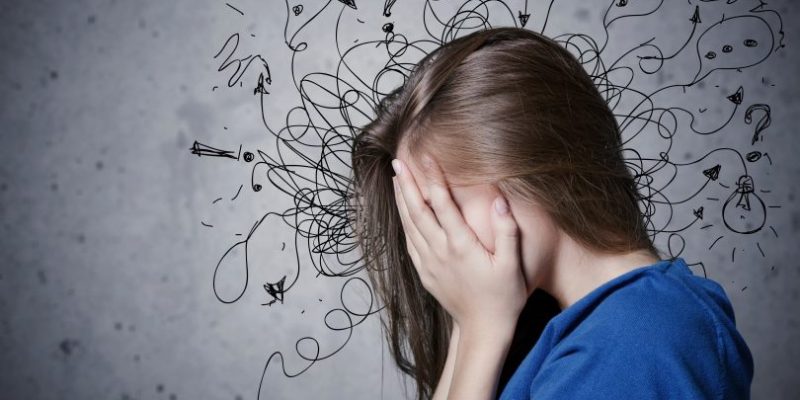Anxiety is a natural response of the body. Over thousands of years, it has allowed humans to survive. And although we go through episodes of this disorder at all ages, anxiety in children and adolescents involves particular characteristics.
Diana Martín, a graduate in psychology and registered in Tenerife, Spain (T-04171), clarifies in the podcast Psicología Contigo that “There are symptoms that are more classic in childhood and adolescence, but anxiety is, in principle, always adaptive.” It’s a fight or flight response that our body triggers when it interprets that something may be dangerous.
Is anxiety the same as fear?
The concepts of fear, phobia, and anxiety aren’t the same thing. Although it’s common for this confusion to appear in the context of child psychotherapy, it’s worth highlighting the differences.
Anxiety is a response to a threat. It’s something that’s natural and and to be expected. However, when normal levels are exceeded, then disorders appear.
Although we have a very negative view of anxious episodes, we must understand that they’re necessary. Without this response, there would be no human evolution. Perhaps we wouldn’t even exist as a species today, as it served us on multiple occasions to escape dangers or to face them successfully.
At the same time, fear is a natural emotion that, if it meets certain parameters according to the child’s development, is considered normal. “A child who, up to two years of age, is afraid of being separated from parents or, at six years of age, is afraid of imaginary beings is to be expected,” Diana Martín proposes as examples. When fear is excessive, we enter the realm of phobias.
According to some statistics, around 7% of children and adolescents between 3 and 17 years old have anxiety. In turn, between 3% and 15% of the world’s population is estimated to have a specific phobia.
Why does excessive anxiety appear in children?
All children will have anxiety at different times in their lives. It’s a physiological response. But why does it manifest itself in people in an extreme way and generate a disorder?
“The origin of anxiety is multifactorial,” postulates Diana Martín. It’s related to biological, genetic, psychological, and social factors. Let’s look at each of them in detail:
- Psychological: Especially, the experiences and how we deal with them in childhood. All of this generates emotional traces of traumas, both from what we experience and what we don’t experience.
- Biological: Imbalances in the concentrations of neurotransmitters, such as serotonin or dopamine, can influence emotional regulation. Also, alterations in the response modality of the autonomic nervous system, especially in the activation of the sympathetic nervous system.
- Genetic: There’s evidence that there are genes associated with the development of anxiety and depression disorders. There are also people who are hypersensitive to stress due to temperament traits that they inherited. However, genetics alone isn’t responsible for anxiety, and interaction with elements of the environment is crucial.
- Social: The family environment can greatly influence the child’s way of coping. The educational styles that adults implement will be key. Overprotection and avoidant attachment are associated with extreme anxiety in childhood. On the contrary, secure attachment, with affection and limits, would be protective. Here the support social network should also be mentioned, including friends.
Types of anxiety in children
This disorder can manifest itself in different ways during childhood. Symptoms of anxiety in children vary, and sometimes there will be verbal expression, and sometimes there won’t. The following are the most common presentations:
- Panic disorder: This is the acute form of anxiety. Symptoms appear suddenly with physical manifestations, such as palpitations and shortness of breath.
- Social anxiety disorder: This is the fear of social situations with other people. These are usually children who don’t want to go to school or who prefer not to hang out with peers for fear of the judgment that will be passed on them.
- Generalized anxiety disorder (GAD): This is an extreme and severe form. Children have multiple symptoms, such as nightmares, frequent crying, irritability, difficulty concentrating, and poor appetite.
- Separation anxiety disorder: This is an anxiety that’s necessary for the development of babies. It usually manifests itself around eight months, when the child fears strangers and expresses desperation when left alone or when their parents are out of sight. The persistence of this behavior beyond preschool age must be addressed.
Why do anxious episodes appear in adolescence?
Adolescents can have difficulties managing emotions that come from childhood. Adolescence is a stage of emotional lability, so the risk of suffering from mental health disorders is higher.
According to psychologist Martín, many young people show up at her office talking a mile a minute. They don’t understand what’s happening to them, and they’re the first to despair because of it.
Keep reading:
The Eight Most Common Problems in Adolescence
Factors that influence adolescent anxiety
Hormones could play an important role in anxious behavior. Cortisol, the molecule associated with stress, is elevated in the adolescent period. When cortisol levels are too high, emotional processing and decision-making abilities are affected.
Another factor is family. The first containment network that should be present may fail. A family that has provided a space for dialogue and a solid foundation of connection since childhood gives adolescents the opportunity to better face their problems. On the contrary, the absence of these foundations favors anxious behaviors.
There are adolescents who do not talk to their parents about issues with emotional weight because their family has not previously been interested in things with less emotional weight, such as their daily interests
In the times we live in, digital connectivity also plays its part in the appearance of anxiety disorders. Young people see unreal images of references on social networks and want to look like them, exposing themselves to judgment and seeking external approval through likes or comments. “In my opinion, adolescents shouldn’t have social media,” says Martín.
How is anxiety diagnosed in children and adolescents?
The diagnosis of an anxiety disorder, both in children and adolescents, requires evaluation by mental health professionals. An interview will first be conducted to obtain information about the symptoms and their duration.
Confirmation will then be attempted with some standardized questionnaires or specially designed evaluation scales, such as the following:
- General anxiety disorder-7 (GAD-7): Designed for adults but can also be used for adolescents.
- Preschool Anxiety Scale (PAS): This evaluation is designed only to evaluate anxiety in preschool children.
- Screening for Child Anxiety-Related Emotional Disorders (SCARED): This is a scale that assesses symptoms in various areas.
- Spence Children’s Anxiety Scale (SCAS): Covers various types of anxiety, such as separation anxiety, social phobia, generalized anxiety, and other specific disorders.
The scales are used as an integral part of the diagnosis but don’t constitute the complete evaluation. The interpretation of the results must be done in the context of each patient.
What are the treatment options?
Cognitive behavioral therapy and the use of selective serotonin reuptake inhibitor medications have demonstrated effectiveness in the treatment of anxiety disorders in childhood, according to the Clinical Practice Guideline of the American Academy of Child and Adolescent Psychiatry.
As part of cognitive behavioral therapy, techniques of gradual exposure to feared situations, cognitive restructuring, and learning coping skills are included. With younger children, play therapy is a valid alternative.
As for drugs, the most prescribed are fluoxetine and sertraline, almost always respecting the minimum age of six years.
Consultation with a mental health professional is essential if anxiety disorders are suspected in a child. The first thing the psychologist will do is certify the diagnosis and determine whether or not there’s a process that needs support.
To do this, “we must understand that the anxiety problem that a child may have isn’t isolated to the family environment,” says Diana Martín. The way the family regulates itself emotionally has a lot to do with childhood anxiety.
Emotional regulation, when we’re children, is provided through reference figures. Little ones are regulated through their parents. So, the strategies to reduce anxiety will mainly involve parents and caregivers.
Therefore, the idea of adults taking their children to therapy, leaving them for an hour a week, and then going to pick them up doesn’t make sense. The lack of family involvement prevents systemic therapeutic work.
Strategies to accompany anxiety in adolescents
Communication is the pillar of support. In the family environment, if the adolescent doesn’t feel confident enough to open up and comment on what’s happening to them, it’ll be difficult to provide support, as the secrecy of this age will work against them.
Assertive communication includes making them aware of the adults’ concerns, even if the expected response isn’t received. Parents can tell their teens that they’re concerned and that they’re willing to talk whenever they want.
When a father or mother wants to approach their adolescent and is unsuccessful, they at least have to make it clear that they’re accessible, that if at any time they need them, they can count on them.
One option is to suggest therapeutic writing. That is, writing to channel what happens to them. Of course, this must be adapted to the digital world of teenagers, with the option for them to write notes on their mobile phones, for example.
Anxiety is multifactorial, and the environment is key to providing help
An anxiety disorder can’t be attributed to a single cause, especially when it comes to children and adolescents.
Is it possible to prevent the problem? With open, assertive family communication based on secure attachment, it’s at least feasible to reduce the risk of our children going through a state of extreme anxiety.
Always consider seeking help from a mental health professional. Through different approaches, a psychologist can provide stress management, relaxation, breathing, and mindfulness techniques. It also works with the child or adolescent to address specific situations that cause anxiety, helping them change negative thought patterns and cognitive distortions.
The post Anxiety in Children and Adolescents: Under the Expert Eye appeared first on Exploring your mind.


















Comments